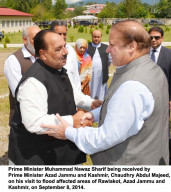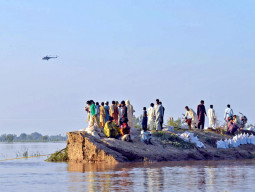
The torrential rains and ensuing floods that have swamped vast swathes of central Punjab are feared to bring down production of key crops, leading to shortage of food and other commodities besides increase in their prices.
Cotton and rice plantations, among other crops, have been damaged by the heavy showers and many farmers have suffered hefty losses, discussions with government officials and agriculture sector players reveal.
Most of the farmers solely bank on farming to feed their families and have no other source of income. Initially, they were excited when rains arrived as the showers would have left a good impact on their crops.
The farmers usually have no savings to cultivate their crops again and look after their families as 80% of landowners are small farmers having less than 12.5 acres of land, agricultural experts say.
Most of the peasants own less than five acres of land and they cannot bear heavy losses. Assistance from the government is the only way that could revive their livelihood, experts added.
Controlling floodwaters, ravaging through Punjab and threatening Sindh as well, has emerged as a new challenge for the government, which already faces issues such as a weakening economy, political uncertainty and power shortages.
“Floods have wreaked havoc in several areas of Punjab, destroying standing crops over thousands of acres, killing livestock and washing away hundreds of villages,” said an official of the Punjab Agriculture Department while talking to The Express Tribune.
The scale of devastation suggested that the farmers had suffered millions of rupees worth of losses, he added.
Agricultural experts fear widespread damage to the rice and cotton belt as well as to other plantations. Many rice fields have been submerged and the overflowing Chenab and Jhelum rivers could sweep away the cotton crop in the southern belt of Punjab.
Consumers have already started complaining about shortage of commodities in the grain and weekly markets. Vegetable fields have also been swamped on a large scale.
Gujranwala district has so far been the worst hit area in Punjab. “Here, the raging floodwaters have destroyed paddy fields over 50,000 acres and affected 10,000 acres sown with other crops,” said Hameed Chaudhry, District Officer of the Punjab Agriculture Department Gujranwala.
Agriculture land in nearby areas of Sialkot, Narowal, Gujrat, Mandi Bahauddin, Hafizabad and Sheikhupura had also been adversely affected, he added.
Chaudhry, however, said it was difficult to come up with a loss estimate at this stage and it could only be made once the water receded.
In Faisalabad and adjoining areas, rains and floods had hit crops of corn, rice and vegetables, said Basheer Afzal Warraich, District Officer of the Punjab Agriculture Department Faisalabad.
Floods in Ravi River destroyed 1,033 acres of rice field, sugarcane cultivated over 542 acres, corn on 1,095 acres and cotton on 85 acres in Tandlianwala tehsil of Faisalabad, he added.
Besides the crops, infrastructure has also been torn apart in over 100 villages in Chiniot and Jhang districts because of floods in Chenab River.
“A large number of cattle also perished in the deluge, which may lead to increase in their prices before Eidul Azha, which is less than a month away,” an expert pointed out.
The government did not learn any lesson from the destruction caused by the previous floods in the country, say some angry farmers. The devastation caused to the agriculture sector could have been averted had the government built water reservoirs and an effective drainage system, they say.
Published in The Express Tribune, September 10th, 2014.
Like Business on Facebook, follow @TribuneBiz on Twitter to stay informed and join in the conversation.









































COMMENTS
Comments are moderated and generally will be posted if they are on-topic and not abusive.
For more information, please see our Comments FAQ